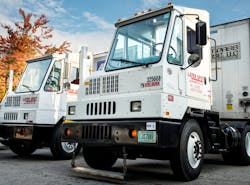Yard trucks are called many things by many people: shunt trucks, switchers, hostlers, terminal tractors, yard horses, etc. What isn’t conveyed in those names is just how rigorous a yard truck fifth wheel has to be.
The average over-the-road fifth wheel couples between one time a day and one time a week, says Robbie Laney, P.E., director of sales, Fontaine Coupling Solutions. In contrast, the typical yard truck fifth wheel couples 150 times per day, with some 24/7 operations coupling more than 2,000 times a week.
Fontaine Coupling Solutions (www.fontainecouplingsolutions.com) manufactures fifth wheels specifically for the terminal tractor market.
What does it take to withstand this harsh environment?
“For starters, yard truck fifth wheels typically have higher load ratings,” he explains. “The two most common are the Holland FW35 series, with a 70,000-lb load rating, and the Fontaine Armor, with an 80,000-lb load rating. By comparison, the typical over-the-road fifth wheel is rated in the 50,000-lb range.”
Some yard truck users even opt for a 100,000-lb fifth wheel, but the pricing of the unit – approximately 300 percent higher – makes this option only reasonable for very specific applications, such as cargo ship operations that frequently get containers from overseas that are immensely overloaded.”
LIGHTER LOADINGS
Approximately 70 percent of all yard trucks operate at warehouse distribution centers where the loads are typically much lighter but the coupling rates are much greater, observes Fontaine’s Laney. These high couple rates mean rebuilds are required more frequently, six months to 1.5 years on average.
Last year, Fontaine introduced its Armor yard truck fifth wheel to address these quick rebuilds.
“The locking jaw can be removed through a cavity in the top plate, after removing a protective wear plate, so that the fifth wheel can be rebuilt in 15 minutes,” he says. “All locking components can be replaced without removing the wheel from the truck in less than an hour.”
OTHER APPLICATIONS
Yard trucks also operate in rail and industrial applications where the coupling rate and load requirements can vary greatly.
“In rail yards, yard trucks are often forced to ‘side shoot’ the trailer – backing in at 45- to 90-degree angle – in order to couple to chassis that have been stacked very closely together based on the space constraints of the rail yard,” explains Laney. “Some fifth wheels have been designed specifically for the yard truck market by ensuring that missed couples – missing the throat of the fifth wheel – does not damage the locking mechanism of the fifth wheel itself.”
Warranties for yard truck fifth wheels, due the tough requirements put on them by the variety of applications they serve, are typically one-year materials and workmanship, he notes.
“Selecting the right fifth wheel for your yard truck application – based on load requirements, coupling rates, rebuild cycles and damage probability – is critical to the success of your operation,” emphasizes Laney. “In this market especially, uptime equates to more efficient operations and thus higher profits for your company.”
About the Author

